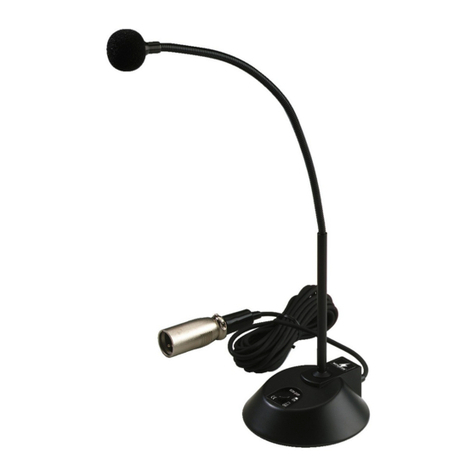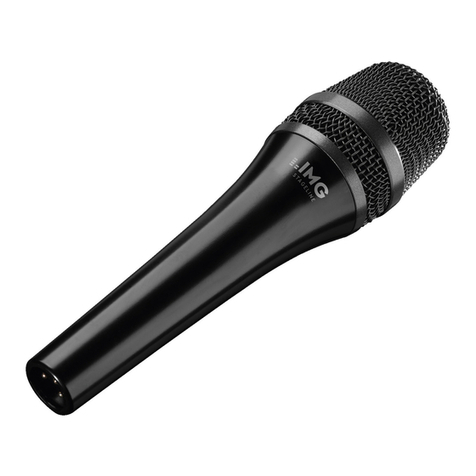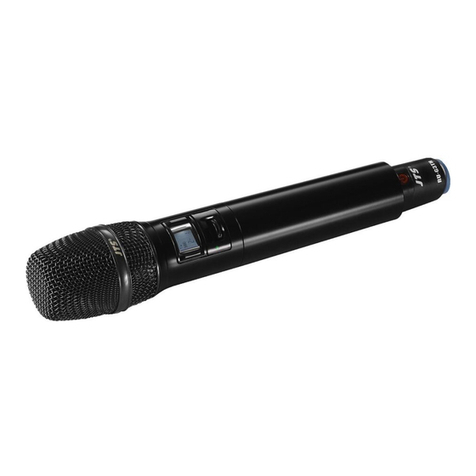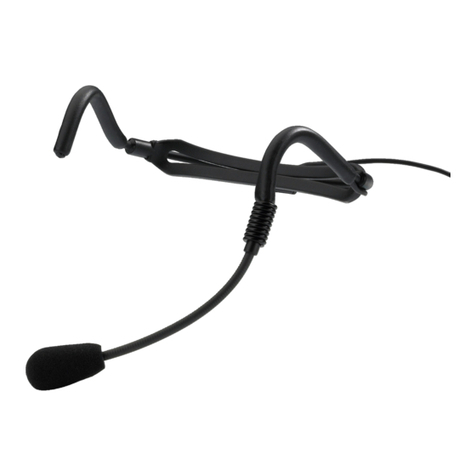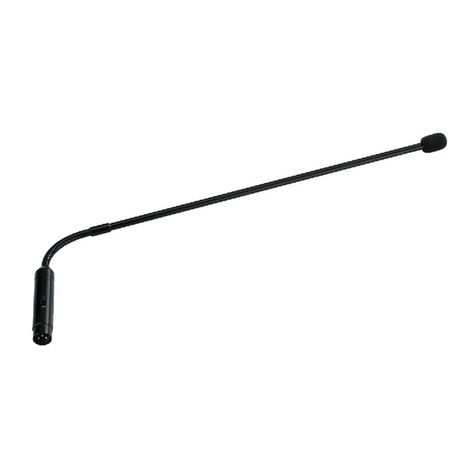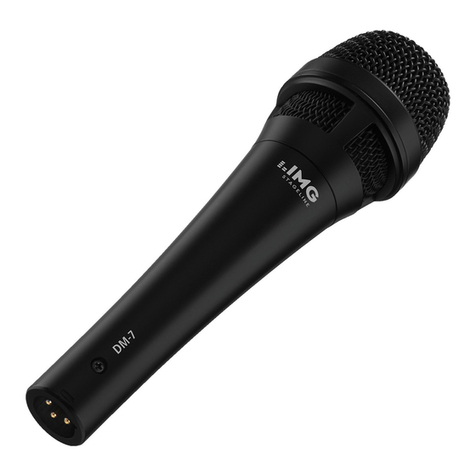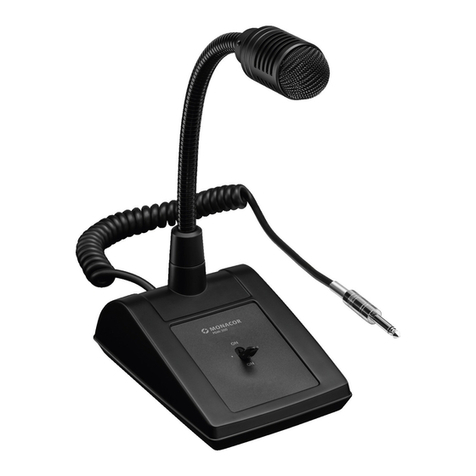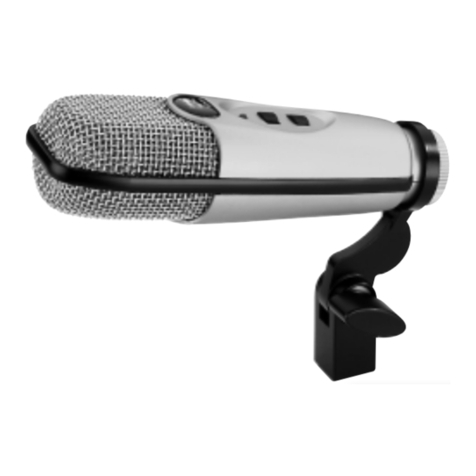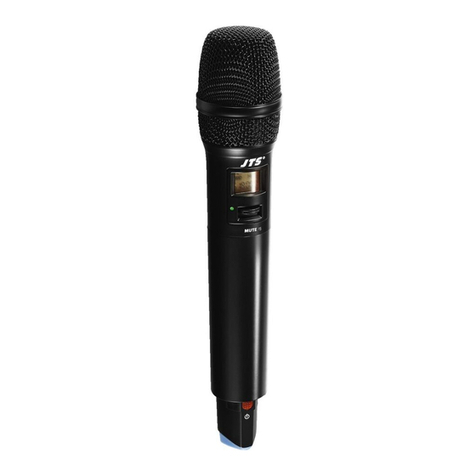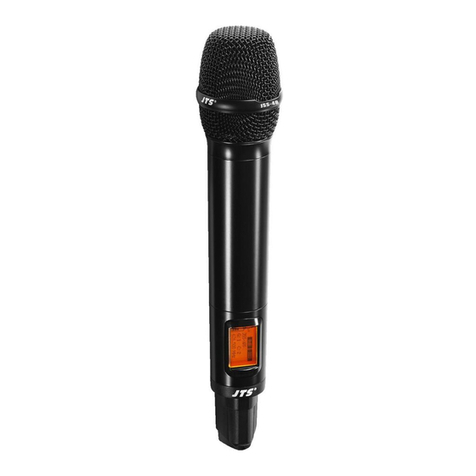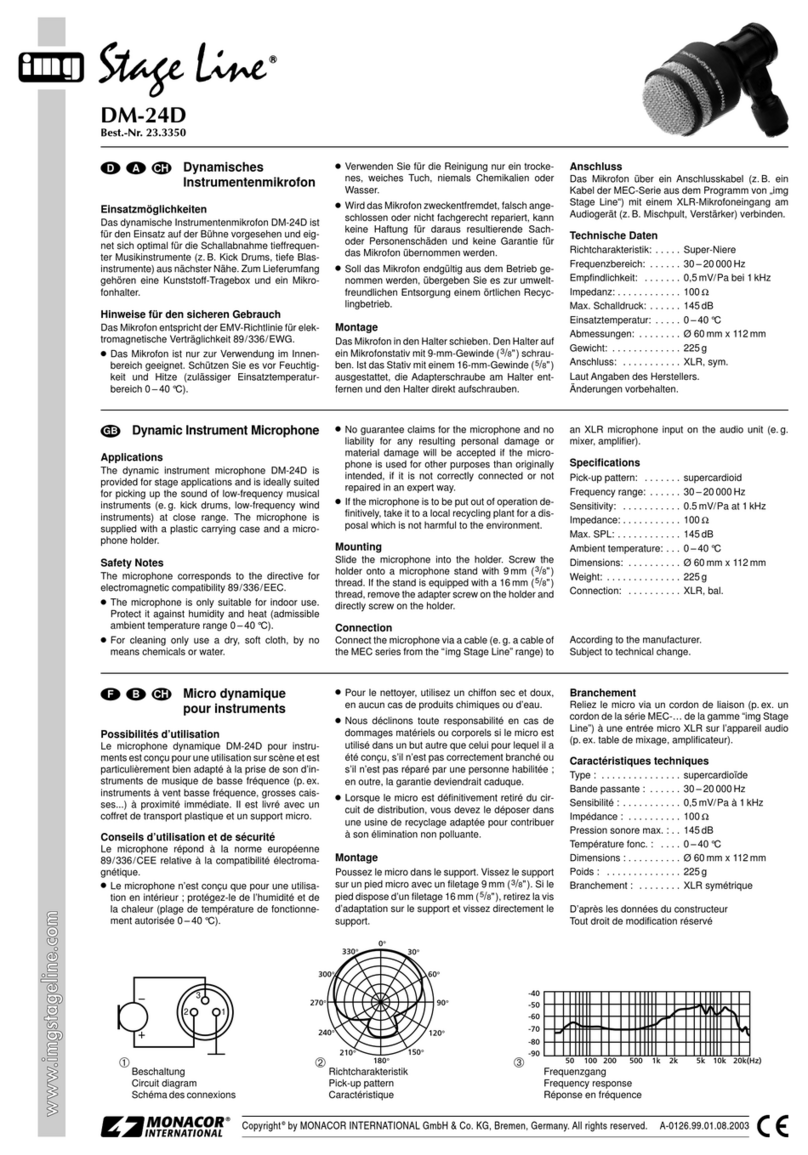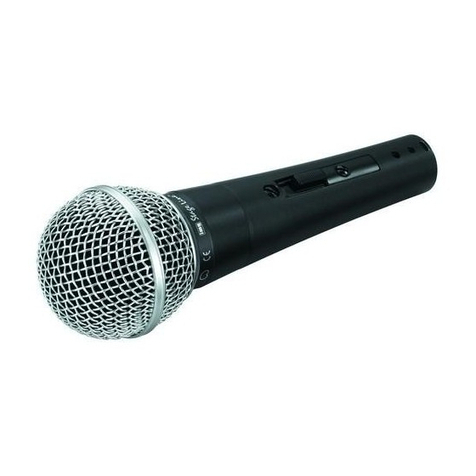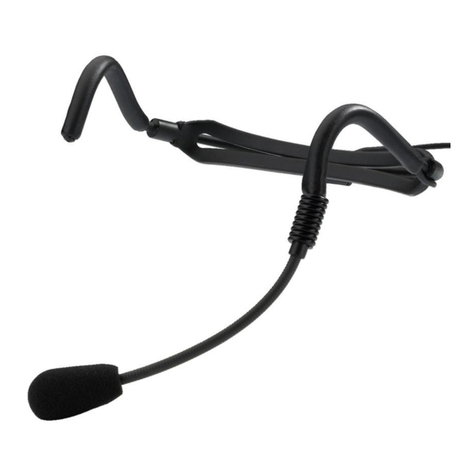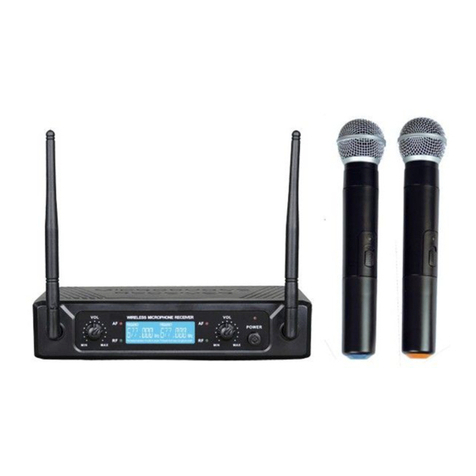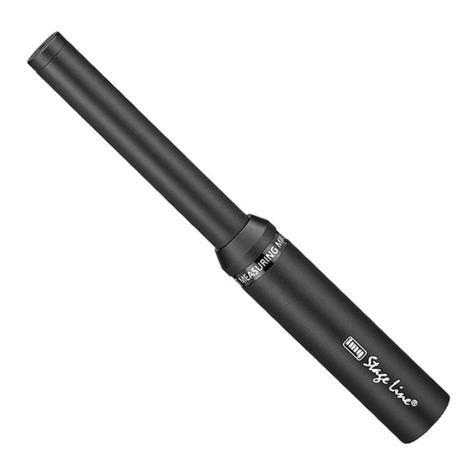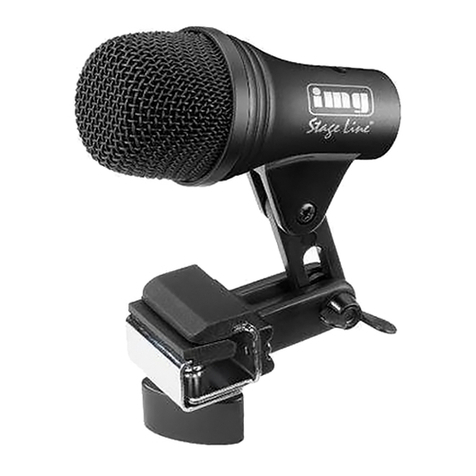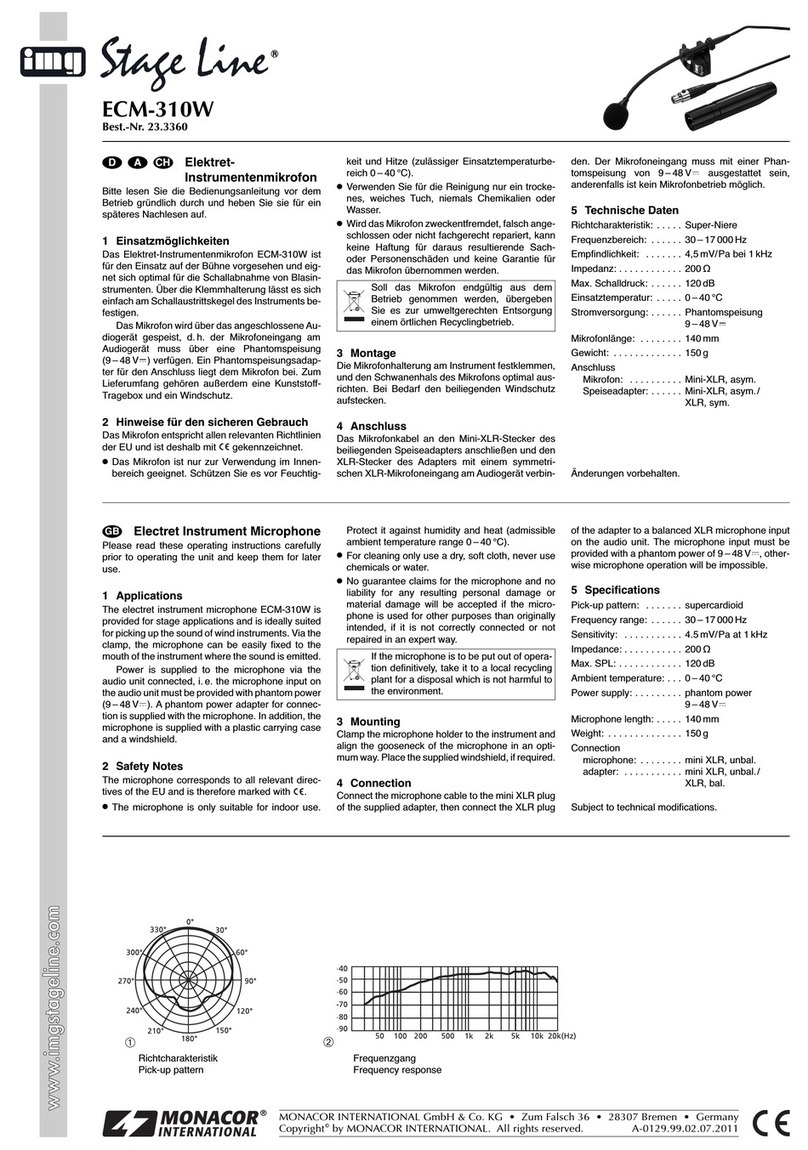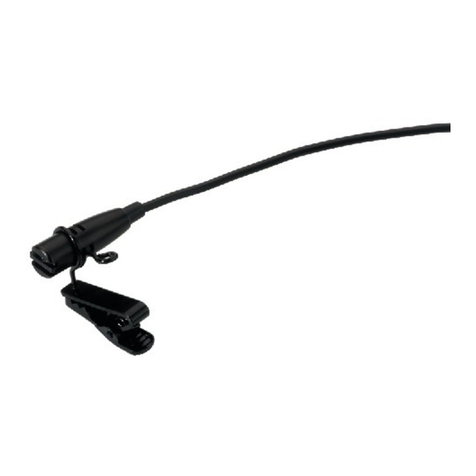Schema elettrico
Diagrama de circuito
Schemat obwodu
Microfono dinamico
Vi preghiamo di leggere attentamente le presenti
istruzioni prima della messa in funzione e di con-
servarle per un uso futuro.
1 Possibilità dʼimpiego
Il microfono dinamico è indicato in maniera ottimale
per applicazioni di canto e di lingua parlata sul pal-
coscenico, a teatro, in discoteca ecc. Sono in dota-
zione un supporto per il microfono, un cavo di colle-
gamento e una custodia.
2 Avvertenze di sicurezza
Il microfono è conforme a tutte le direttive richieste
dellʼUE e pertanto porta la sigla .
GUsare il microfono solo allʼinterno di locali e pro-
teggerlo dallʼacqua gocciolante e dagli spruzzi
dʼacqua, da alta umidità dellʼaria e dal calore
(temperatura dʼimpiego ammessa fra 0 e 40 °C).
GPer la pulizia usare solo un panno morbido,
asciutto; non impiegare in nessun caso prodotti
chimici o acqua.
GNel caso di uso improprio, di collegamento sba-
gliato o di riparazione non a regola dʼarte non si
presta nessuna garanzia per il microfono e non si
assume nessuna responsabilità per eventuali
danni a persone o a cose.
3 Messa in funzione
Il microfono e il cavo di collegamento sono simme-
trici mentre il jack è asimmetrico (vedi figura). Se si
effettua il collegamento simmetrico per mezzo di
quel cavo, occorre sostituire il jack a 2 poli con uno
a 3 poli o con un connettore XLR.
1) Collegare il microfono con lʼingresso microfono di
un apparecchio audio (p. es. mixer, registratore,
amplificatore) per mezzo del cavo in dotazione.
Se si desidera eliminare il microfono defi-
nitivamente, consegnarlo per lo smalti-
mento ad unʼistituzione locale per il rici-
claggio.
2) Avvitare il supporto per il microfono su uno sta-
tivo per microfoni dotato di filettatura 16 mm (5/8″)
e inserire il microfono nel supporto.
3) Per accendere il microfono spostare lʼinterruttore
da “OFF” (microfono spento) a “ON”.
4 Dati tecnici
Sistema: . . . . . . . . . . . . . cardioide
Gamma di frequenze: . . . 80 – 14 000 Hz
Sensibilità: . . . . . . . . . . . 1,5 mV/Pa a 1 kHz
Impedenza: . . . . . . . . . . . 600 Ω
Temperatura dʼimpiego: . 0 – 40 °C
Dimensioni: . . . . . . . . . . . ∅52 mm × 180 mm
Peso: . . . . . . . . . . . . . . . 260 g
Collegamenti
microfono: . . . . . . . . . XLR, simm.
cavo low noise, 6 m: . . XLR, simm./
jack 6,3 mm, asimm.
Con riserva di modifiche tecniche.
Micro Dinámico
Por favor, lea estas instrucciones de funciona-
miento cuidadosamente antes de usar el aparato y
guárdelas para usos posteriores.
1 Posibilidades de utilización
El micro dinámico se adapta particularmente a utili-
zaciones para cantes y discursos en escenarios, en
teatros y en discotecas, etc. Le entregamos tam-
bién un soporte de micro, un cable de conexión y
una maleta de transporte.
2 Consejos de seguridad y de utilización
Este micrófono corresponde a todas las Directivas
requeridas por la UE y por eso está marcado con .
GEl micrófono sólo está indicado para su uso en inte-
rior. Protéjalo contra proyecciones de agua, salpi-
caduras, humedad elevada del aire y calor (tem-
peratura de funcionamiento admisible 0 – 40 °C).
GPara limpiarlo, utilice un trapo seco y suave, en
ningún caso productos químicos o agua.
GRechazamos cualquier responsabilidad en caso
de daños materiales o corporales si el micro se
utiliza en otro fin para el cual ha sido fabricado, si
no está correctamente conectado o reparado por
una persona habilitada. Por estos mismos moti-
vos el aparato carecería de todo tipo de garantía.
3 Funcionamiento
El micro y el cable de conexión son simétricos, la
toma jack 6,35 es asimétrica (vea esquema). Si
debe conectar el micro vía este cable de manera
simétrica, cambie la toma jack 2 polos por una toma
jack 3 polos o una toma XLR.
1) Conecte el micro vía el cable con la entrada
micro de un aparato audio (por ejemplo mesa de
mezcla, grabador, amplificador).
Cuando el micro está definitivamente saca-
do del servicio, debe depositarlo en una
fábrica de reciclaje de proximidad para con-
tribuir a una eliminación no contaminante.
2) Atornille el soporte de micro sobre un pie de
micro con una rosca de 16 mm (5/8″) y coloque
le micro sobre el soporte.
3) Para conectar el micro, ponga el interruptor de la
posición “OFF” (micro apagado) en la posición
“ON”.
4 Características técnicas
Directividad: . . . . . . . . . . cardioide
Gama de frecuencias: . . 80 – 14 000 Hz
Sensibilidad: . . . . . . . . . . 1,5 mV/Pa a 1 kHz
Impedancia: . . . . . . . . . . 600 Ω
Temperatura func.: . . . . . 0 – 40 °C
Dimensiones: . . . . . . . . . ∅52 mm × 180 mm
Peso: . . . . . . . . . . . . . . . 260 g
Conexiones
Micro: . . . . . . . . . . . . . XLR, sim.
Cable Low noise 6 m: . XLR, sim./
Jack 6,35, asim.
Sujeto a modificaciones técnicas.
DM-2100
Best.-Nr. 23.1630
wwwwww..iimmggssttaaggeelliinnee..ccoomm
®
MONACOR INTERNATIONAL GmbH & Co. KG
•
Zum Falsch 36
•
28307 Bremen
•
Germany
Copyright
©
by MONACOR INTERNATIONAL. All rights reserved. A-0275.99.02.10.2011
Mikrofon Dynamiczny
Prosimy o uważne przeczytanie poniższej instrukcji
przed użyciem urządzenia, oraz o zachowanie tek-
stu do wglądu.
1 Zastosowanie
Mikrofon dynamiczny jest przeznaczony do wokalu
i mowy na scenie, w teatrze, dyskotece, etc. W
zestawie znajduje się dodatkowo uchwyt, kabel
mikrofonowy oraz pokrowiec.
2 Informacje Dotyczące Bezpieczeństwa
Urządzenie spełnia wymogi norm obowiązujących
w Unii Europejskiej, jest zatem oznaczone symbo-
lem .
GUrządzenie przeznaczone jest do użytku jedynie
wewnątrz pomieszczeń. Należy chronić je przed
bezpośrednim kontaktem z wodą, przed działa-
niem wilgoci oraz wysokiej temperatury (dopusz-
czalna temperatura otoczenia pracy to 0 – 40 ºC).
GDo czyszczenia należy używać jedynie czystego
i suchego kawałka materiału. Nie używać wody,
ani środków chemicznych.
GJeżeli urządzenie jest używane do innych niż
wskazane celów, jest nieprawidłowo podłączone,
obsługiwane w niewłaściwy sposób lub jest
naprawiane przez niewykwalifikowane osoby,
żadne roszczenia gwarancyjne, ani roszczenia
wynikające z uszczerbku zdrowia lub zniszczenia
mienia nie będą akceptowane.
3 Podłączanie
Mikrofon oraz kabel połączeniowy są symetryczne.
Jednak wtyk jack 6,3 mm jest niesymetryczny (patrz
rysunek). Aby podłączyć mikrofon do gniazda syme-
tryczego należy zamienić wtyk jack 6,3 mm mono,
na stereo, lub wtyk XLR.
1) Mikrofon należy podłączyć do wejścia mikrofo-
nowego urządzenia (np.: miksera, wzmacniacza,
etc.).
Jeżeli urządzenie nie będzie więcej uży-
wane należy je utylizować zgodnie z prze-
pisami dotyczącymi ochrony środowiska.
2) Dokręcić uchwyt mikrofonowy do statywu za
pomocą śruby 16 mm (5/8″) i wsunąć mikrofon w
uchwyt.
3) Aby włączyć mikrofon należy przesunąć przełą-
cznik z pozycji “OFF” do “ON”.
4 Dane Techniczne
Charakterystyka
kierunkowa: . . . . . . . . . . kardioidalna
Zakres częstotliwości: . . 80 – 14 000 Hz
Czułość: . . . . . . . . . . . . . 1,5 mV/Pa przy 1 kHz
Impedancja: . . . . . . . . . . 600 Ω
Dopuszczalna tem-
peratura otoczenia pracy: 0 – 40 °C
Wymiary: . . . . . . . . . . . . ∅52 mm × 180 mm
Waga: . . . . . . . . . . . . . . . 260 g
Połączenia
Mikrofon: . . . . . . . . . . XLR, symetryczne
Przewód mikro. 6 m: . . XLR, symetryczny/jack
6,3 mm, niesymetryczne
Z zastrzeżeniem możliwości zmian.
E
I
PL
